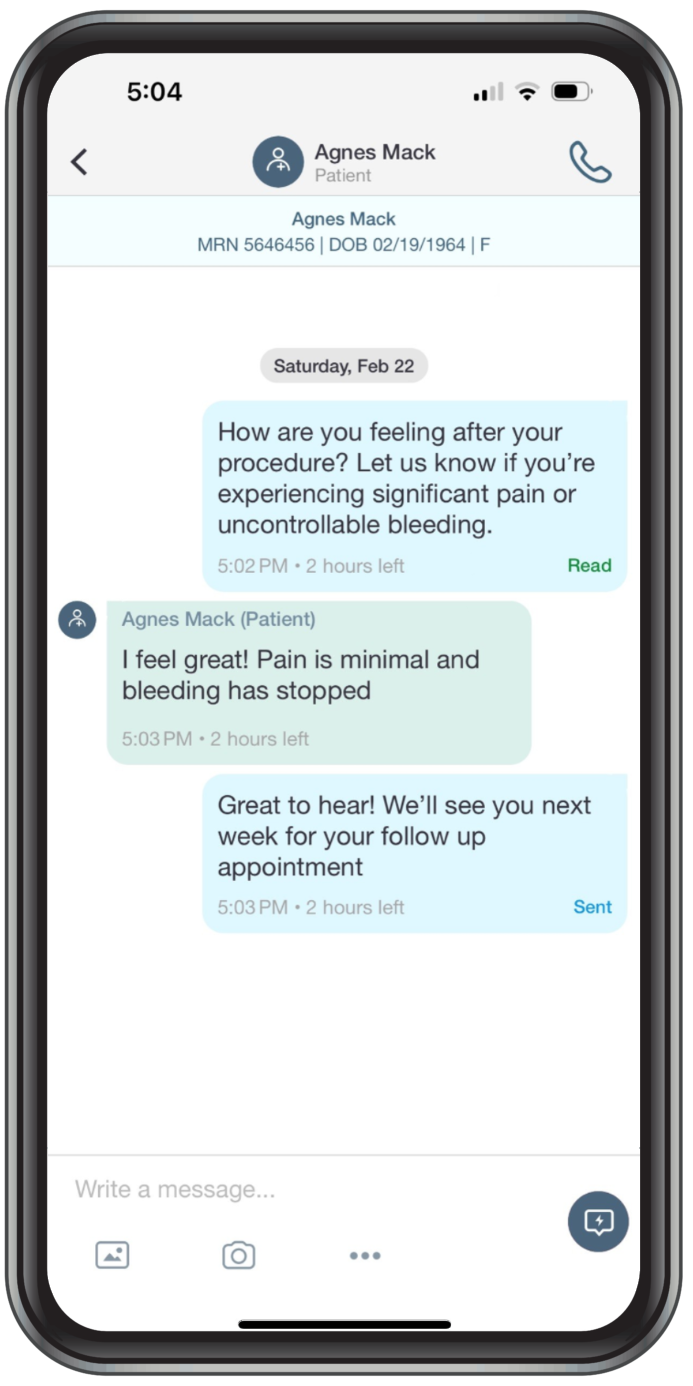
How Investing in Patient Satisfaction Reduces Churn and Drives Revenue
For healthcare organizations, patient retention is more than a metric—it’s a financial imperative. With recurring visits accounting for a significant portion of hospital revenue, reducing patient churn is essential to long-term sustainability[1]. While some churn is unavoidable due to factors like relocation or insurance changes, a large portion stems from dissatisfaction—something hospitals can control.
Improving patient satisfaction isn’t just about better care; it’s about building loyalty, increasing lifetime value, and reducing costly turnover[2]. In fact, dissatisfied patients are 4x more likely to leave within six months, and each lost patient can cost a facility up to $200,000 over their lifetime[3].
What Drives Patient Satisfaction?
Patient satisfaction is typically measured across four key dimensions[4]:
- Care quality
- Empathy
- Reliability
- Responsiveness
Hospitals that invest in these areas see measurable improvements in retention, referrals, and revenue. Here are nine proven strategies to reduce churn by enhancing patient satisfaction.
1. Improve Communication with Patients
Effective communication is one of the strongest predictors of patient satisfaction. Patients want clear explanations of procedures, treatment plans, and post-visit care[5]. Yet short appointment windows often leave little time for questions.
Solution: Implement secure texting and telehealth platforms to extend communication beyond the office. These tools allow providers to:
- Send follow-up instructions
- Answer questions in real time
- Demonstrate empathy and attentiveness
This not only improves outcomes but also builds trust—key to long-term loyalty.
2. Minimize In-Office Wait Times
Long wait times are a top complaint among patients. According to Weatherby Healthcare, patients spend one-third of their visit waiting to be seen[6].
Solution: Use automated appointment reminders and scheduling tools to reduce no-shows and late arrivals. This streamlines patient flow and improves the overall experience.
3. Automate Lab and Prescription Orders
Manual processes for labs and prescriptions are prone to delays and errors. Lost paperwork or miscommunications can frustrate patients and slow down care.
Solution: Adopt electronic ordering systems that:
- Submit lab and prescription requests instantly
- Flag potential drug interactions
- Reduce delays in treatment
Studies show that automating these processes can boost satisfaction by 8–11%[7].
4. Enhance Access to Patient Records
Fragmented data across departments can lead to delays and confusion. Patients expect their providers to have a complete view of their health history.
Solution: Integrate Electronic Health Records (EHR) across departments to:
- Provide real-time access to test results and medical history
- Reduce redundant testing
- Improve care coordination
EHR integration can increase satisfaction by 10–15%[7].
5. Enable Real-Time Collaboration Among Providers
Patients often interact with multiple specialists, and poor coordination can lead to inconsistent care.
Solution: Use clinical collaboration platforms that support:
- Real-time messaging between care team members
- Shared treatment plans
- Immediate alerts for critical updates
This ensures all providers are aligned, improving both outcomes and patient confidence.
6. Reduce Fragmentation in Patient Experience
Patients may interact with 50–60 staff members during a hospital stay. While necessary, this can feel impersonal and overwhelming[3].
Solution: Streamline touchpoints by:
- Assigning dedicated care coordinators
- Training staff in customer service
- Reducing unnecessary handoffs
A more cohesive experience fosters comfort and trust.
7. Prioritize Facility Design and Cleanliness
Environment matters. A survey found that 78% of patients care about the design, cleanliness, and comfort of a facility[6].
Solution: Invest in:
- Clean, well-lit waiting areas
- Comfortable seating and decor
- Clear signage and navigation
A welcoming space enhances the perception of care quality.
8. Educate Patients Beyond the Visit
Time constraints limit how much education providers can offer during appointments. Yet informed patients are more likely to follow treatment plans and feel satisfied.
Solution: Use secure messaging to send:
- Educational resources
- Medication reminders
- Lifestyle tips and FAQs
This shows ongoing care and reduces readmissions.
9. Manage Expectations Proactively
Patients are more satisfied when their experience exceeds expectations[5]. Misalignment between what they expect and what they receive can lead to dissatisfaction.
Solution: Set expectations before the visit by:
- Sending welcome packets or digital guides
- Outlining what to expect during their stay
- Introducing care team roles
This reduces anxiety and improves perception of care.
10. Use Patient Surveys to Drive Improvement
Patient feedback is essential for identifying pain points and improving satisfaction. Hospitals can collect insights through:
- Digital surveys
- Follow-up emails or calls
- Online reviews
- Suggestion boxes
Documenting responses electronically helps track trends and uncover areas for improvement. Communication platforms can also monitor system usage, revealing gaps in responsiveness or engagement.
11. Stay Engaged Between Visits
Ongoing engagement builds loyalty. Hospitals can maintain relationships by:
- Sharing health tips and wellness content
- Highlighting new equipment or staff achievements
- Promoting new procedures or technologies
Use email, SMS, or patient portals to keep communication relevant and HIPAA-compliant.
12. Audit and Optimize Patient Workflows
Evaluating the patient journey—from intake to discharge—can reveal inefficiencies that impact satisfaction. For example:
- Improving internal communication ensures staff are prepared
- Streamlining discharge processes reduces delays
- Offering checkout scheduling encourages return visits
Even small workflow improvements can lead to better experiences and higher retention[8].
Final Thoughts: Satisfaction Is a Strategic Investment
Reducing patient churn starts with improving satisfaction. With CMS incentive programs tying reimbursement to performance, hospitals must prioritize satisfaction to remain competitive. By investing in communication, automation, collaboration, and environment, healthcare facilities can:
- Increase patient loyalty
- Improve outcomes
- Boost revenue
Bottom line: satisfied patients stay longer, refer others, and cost less to serve. For hospitals looking to grow sustainably, patient satisfaction isn’t optional—it’s a strategic advantage.
From secure messaging to patient engagement tools, TigerConnect helps healthcare organizations reduce churn, improve outcomes, and boost revenue.
Request a demo to see how TigerConnect can transform your patient experience.
Sources:
- Mehta SJ. Patient Satisfaction Reporting and Its Implications for Patient Care. AMA J Ethics. 2015;17(7):616-621. Published 2015 Jul 1. doi:10.1001/journalofethics.2015.17.7.ecas3-1507
- Poulos GA, Brodell RT, Mostow EN. Improving quality and patient satisfaction in dermatology office practice. Arch Dermatol. 2008;144(2):263-265. doi:10.1001/archdermatol.2007.58
- Prakash B. Patient satisfaction. J Cutan Aesthet Surg. 2010;3(3):151-155. doi:10.4103/0974-2077.74491
- Yousefi, K., Kargari, M. Patient Relationship Management Method, an Approach toward Patient Satisfaction: A Case Study in a Public Hospital. International Journal of Travel Medicine and Global Health. 2014; 2(1): 11-17.
- Abramowitz S, Coté AA, Berry E. Analyzing patient satisfaction: a multianalytic approach. QRB Qual Rev Bull. 1987;13(4):122-130. doi:10.1016/s0097-5990(16)30118-x
- Hanover Research and Weatherby Healthcare. The portrait of a modern patient. 2017. Available at: https://3d48d5394e5c26eba97c-c2cd0437cc11d2b508db932a8299b2de.r74.cf1.rackcdn.com/media/images/PortraitModernPatient_Executive_rw_v4_f.pdf. Accessed December 14, 2020.
- Roham M, Gabrielyan AR, Archer NP. Predicting the impact of hospital health information technology adoption on patient satisfaction. Artif Intell Med. 2012;56(2):123-135. doi:10.1016/j.artmed.2012.08.001
- McDermott, E. They’re just not that into you: why patients churn (and how to stop them). 2017. Available at: https://www.webpt.com/blog/they-re-just-not-that-into-you-why-patients-churn-and-how-to-stop-them/. Accessed December 14, 2020.
Learn more about Clinical Collaboration Software Platform, Resident Scheduling Software, Physician Scheduling Software, Alarm Management & Event Notification Software & Patient Engagement Software.
Featured Resources
Related Articles










